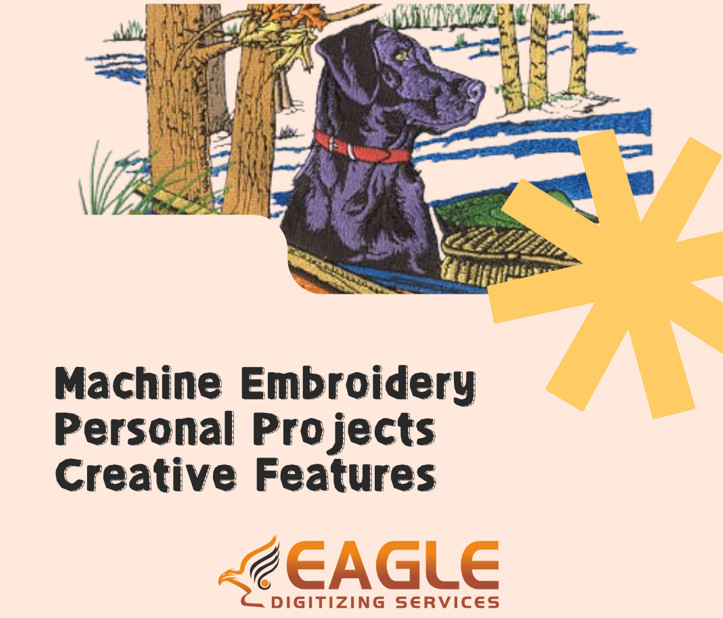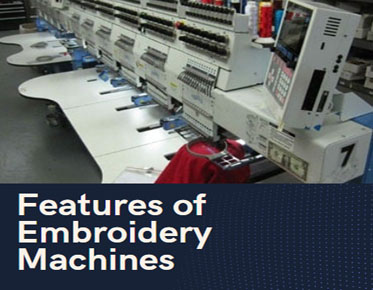How Can You Personalize Projects with Machine Embroidery Through Custom Creations?
In the realm of crafting and personalization, machine embroidery stands out as a versatile and intricate art form. From adding a touch of elegance to garments to creating bespoke gifts, the possibilities are as endless as the imagination. This article explores the realm of machine embroidery, guiding you through its history, techniques, personalization options, and troubleshooting tips, ultimately inspiring you to embark on your creative journey.
Machine embroidery, unlike its traditional counterpart, involves the use of computerized machines to stitch intricate designs onto fabric. Its roots can be traced back to the Industrial Revolution when mechanical embroidery machines were first introduced to streamline the process of embellishing textiles.
Types
of embroidery machines
- Single-needle machines: Ideal for hobbyists and beginners, single-needle machines operate
with one needle and are suitable for simpler designs and smaller projects.
- Multi-needle machines: Designed
for professional embroiderers, multi-needle machines feature multiple
needles that allow for faster stitching and the use of multiple thread
colors without manual thread changes.
- Computerized embroidery machines: The pinnacle of modern embroidery technology, computerized machines are equipped with advanced software interfaces, enabling users to digitize designs and execute complex stitching patterns with precision.
Fabric
choices
Selecting the right fabric is crucial for achieving optimal results in machine embroidery. From delicate silks to sturdy denim, each fabric type presents unique challenges and considerations that must be taken into account during the embroidery process.
Thread
types and colors
The choice of thread can greatly impact the appearance and durability of the embroidered design. From polyester to rayon, metallic to glow-in-the-dark, the variety of thread types and colors available allows for endless creative possibilities.
Hoops
and stabilizers
Hoops are essential for securing the fabric in place during embroidery, preventing shifting and distortion. Stabilizers provide additional support and reinforcement, ensuring clean and crisp stitch quality across various fabric types.
Design
software and files
Embroidery design software enables users to create, edit, and digitize designs for stitching. Compatible file formats such as .dst, .pes, and .jef ensure seamless integration with embroidery machines, allowing for effortless customization and execution.
Pre-made
designs
For those seeking convenience and inspiration, pre-made designs offer a vast selection of motifs, patterns, and styles to choose from. These designs are readily available for purchase or download and can be easily customized to suit individual preferences.
Creating
custom designs
- Digitizing process: Digitizing involves converting artwork or images into a format
compatible with embroidery machines. This intricate process requires
specialized software and skills to ensure the accurate translation of
designs into stitch data.
- Software options for design creation: From industry-standard software like Wilcom and Embird to user-friendly alternatives like SewArt and Hatch, there are numerous software options available for designing and digitizing embroidery patterns.
Preparing
the fabric
Before embroidery can commence, it is essential to prepare the fabric by washing and pressing it to remove any wrinkles or residues that may affect stitch quality.
Hooping
the fabric securely
Proper hooping is crucial for ensuring that the fabric remains taut and stable throughout the embroidery process. Incorrect hooping can lead to puckering, distortion, or misalignment of the design.
Selecting
appropriate stabilizers
Choosing the right stabilizer is essential for achieving professional results in machine embroidery. Whether tear-away, cut-away, or water-soluble, stabilizers provide support and structure to the fabric during stitching.
Basic
stitching techniques
Basic stitches such as running stitch, satin stitch, and fill stitch form the foundation of machine embroidery, providing texture, dimension, and visual interest to designs.
Advanced
techniques for intricate designs
Advanced techniques such as stippling, thread painting, and 3D embroidery push the boundaries of creativity, allowing for the creation of intricate and lifelike designs with depth and detail.
Layering
and appliqué methods
Layering and appliqué techniques involve the placement of fabric or other materials onto the base fabric before stitching, adding dimension, texture, and complexity to the design.
Monogramming
Monogramming allows individuals to add a personal touch to their belongings by embroidering initials, names, or dates onto garments, accessories, and home décor items.
Customizing
with names or initials
Customizing designs with names or initials adds a unique and personalized element to gifts, apparel, and promotional items, making them truly one-of-a-kind.
Incorporating
logos or symbols
Businesses and organizations can enhance brand visibility and recognition by incorporating logos, symbols, or slogans into their embroidered merchandise and promotional materials.
Adding
decorative elements
From floral motifs to geometric patterns, decorative elements can embellish and enhance the aesthetic appeal of embroidered designs, adding personality and charm to any project.
Proper
tension adjustment
Achieving the correct tension is essential for producing neat and even stitches in machine embroidery. Experimenting with tension settings and conducting test stitches can help fine-tune the tension for optimal results.
Using
the right needles
Choosing the appropriate needle type and size based on the fabric and thread being used can prevent thread breaks, needle deflection, and other stitching issues during embroidery.
Testing
designs and settings
Before embroidering onto the final fabric, it is advisable to test the design and settings on a scrap piece of fabric to ensure proper alignment, stitch density, and overall appearance.
Regular
machine maintenance
Regular cleaning, oiling, and servicing of embroidery machines are essential for prolonging their lifespan and maintaining optimal performance. Following manufacturer guidelines and schedules for maintenance can prevent malfunctions and costly repairs.
Thread
breaks or tangles
Thread breaks or tangles can occur due to various factors such as improper tension, dull needles, or thread quality. Addressing these issues promptly and systematically can minimize downtime and frustration during embroidery.
Puckering
or distortion of fabric
Puckering or distortion of fabric may result from inadequate hooping, incorrect stabilizer selection, or excessive tension. Adjusting hooping techniques, stabilizer types, or tension settings can help alleviate these issues and produce smoother embroidery results.
Misalignment
of designs
Misalignment of designs can occur due to inaccurate hooping, improper centering, or software glitches. Double-checking alignment and registration marks, as well as calibrating machine settings, can help ensure precise placement and alignment of designs.
Understanding
error messages
Machine error messages provide valuable insights into potential issues or malfunctions that may arise during embroidery. Consulting the machine manual or manufacturer's troubleshooting guide can help diagnose and resolve error messages effectively.
Trimming
excess threads
Trimming excess threads and jump stitches after embroidery is essential for achieving a clean and polished finish. Sharp embroidery scissors or snips can make precise trimming quick and effortless.
Removing
stabilizers
After embroidery is complete, removing stabilizers from the fabric is necessary to reveal the finished design and ensure softness and flexibility. Tear-away stabilizers can be gently torn away, while cut-away stabilizers require careful trimming around the design edges.
Ironing
and storing finished projects
Ironing embroidered projects on the reverse side with a low-temperature setting help set the stitches and smooth out any wrinkles or creases. Storing finished projects in a cool, dry place away from direct sunlight can prevent fading and discoloration over time.
Washing
and caring for embroidered items
When laundering embroidered items, it is important to follow care instructions specific to the fabric and thread used. Gentle cycle washing with mild detergent, air drying, or low-heat tumble drying, and avoiding harsh chemicals or bleach can help preserve the integrity and vibrancy of embroidered designs.
Apparel
and accessories
From embellished garments and personalized accessories to embroidered footwear and headwear, machine embroidery offers endless possibilities for adding style and flair to everyday wear.
Home
décor items
Transform ordinary household items into works of art with embroidered pillows, table linens, curtains, and wall hangings that reflect your personal taste and creative vision.
Gifts
for special occasions
Celebrate life's milestones and special moments with thoughtful and heartfelt gifts such as monogrammed towels, embroidered baby blankets, and custom-designed keepsakes that will be treasured for years to come.
Business
and promotional items
Promote your brand or business with embroidered merchandise such as logoed apparel, branded uniforms, and promotional giveaways that leave a lasting impression on clients, customers, and partners.
In conclusion, machine embroidery offers a
world of creativity and personalization, empowering individuals to express
their unique style and vision through intricately stitched designs. Whether
you're a seasoned embroiderer or a novice crafter, the journey of exploration
and discovery in the realm of machine embroidery is as fulfilling as the
finished projects themselves. So, unleash your creativity, experiment with
techniques and designs, and embark on your own personalized embroidery adventure today!



